📢 Blog home page: 🏀 Bryant typing the code🏀
📢 Welcome to praise 👍 Collection ⭐ Leaving a message. 📝 Welcome to discuss! 👏
📢 This article was originally written by [Bryant who knocked the code], and was first launched in CSDN 🙉🙉🙉
📢 Since the blogger is learning Xiaobai, there will inevitably be mistakes. If you have any questions, please leave a message in the comment area. Thank you very much! ✨
📖 Boutique column (updated from time to time)[ JavaSE] [Java data structure][LeetCode]
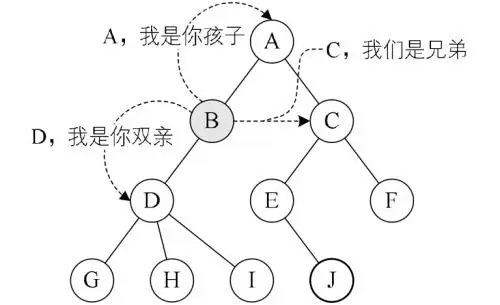
Preorder traversal of binary tree
As like as two peas, the same way is to change the access order of the nodes, and the code is exactly the same, but in order of order.
Title:
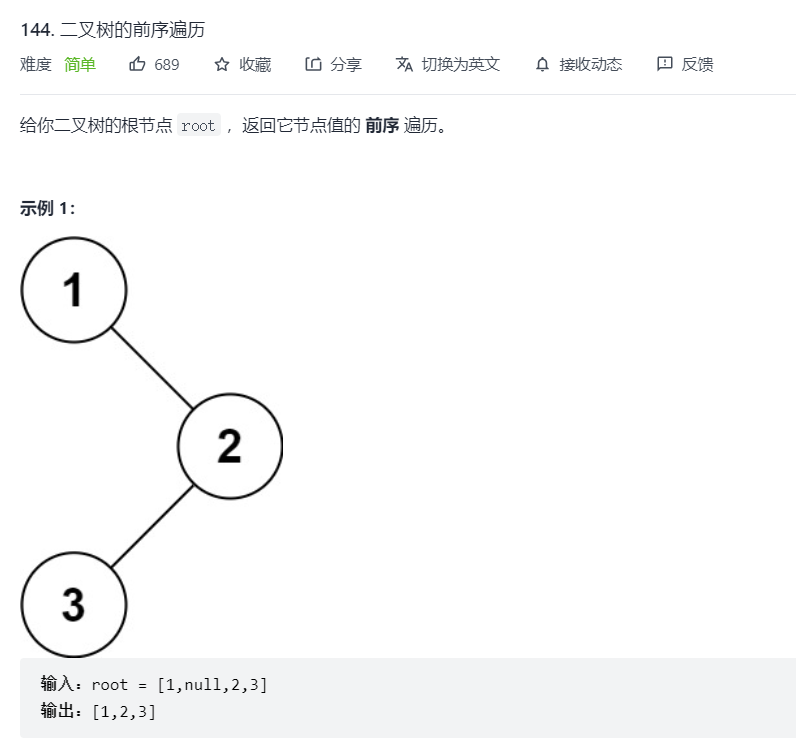
Idea: this question requires that the traversed nodes be put into a List and returned
- Preorder traversal order: root node - > left child node - > right child node
- Judge the root node first. If the root node is empty, return list directly
- Store the currently accessed root node in the sequence table
- Then recursively access the left child node
- Finally, the right child node is accessed recursively
Implementation code:
class Solution {
List<Integer> list = new ArrayList<>();
public List<Integer> preorderTraversal(TreeNode root) {
if(root==null){//Root node empty
return list;//Direct return sequence table
}
list.add(root.val);//Store the value of the currently accessed root node in the sequence table
preorderTraversal(root.left);//Access left node
preorderTraversal(root.right);//Access right node
return list;
}
}
Medium order traversal
Title:
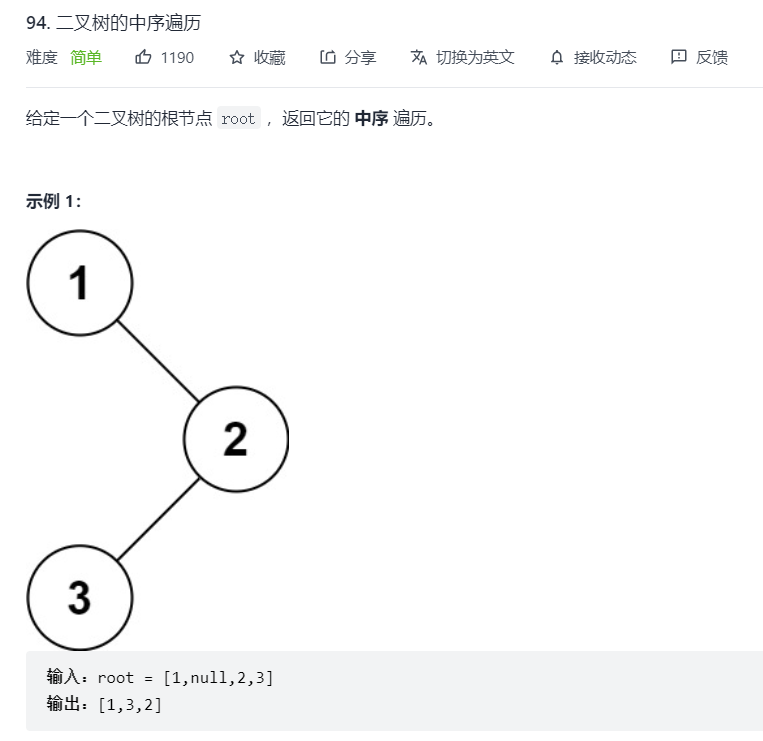
Idea: this question requires that the traversed nodes be put into a List and returned
- Middle order traversal order: left child node - > root node - > right child node
- First judge the current root node. If the root node is empty, directly return to list
- Access left child node
- Store the currently accessed root node value in the sequence table
- Finally, access the right child node
Implementation code:
class Solution {
List<Integer> list = new ArrayList<>();
public List<Integer> inorderTraversal(TreeNode root) {
if(root==null){//Judge whether the current root node is empty
return list;
}
inorderTraversal(root.left);//Access left child node
list.add(root.val);//Store the value of the currently accessed root node in the sequence table
inorderTraversal(root.right);//Access the right child node
return list;
}
}
Subsequent traversal
Title: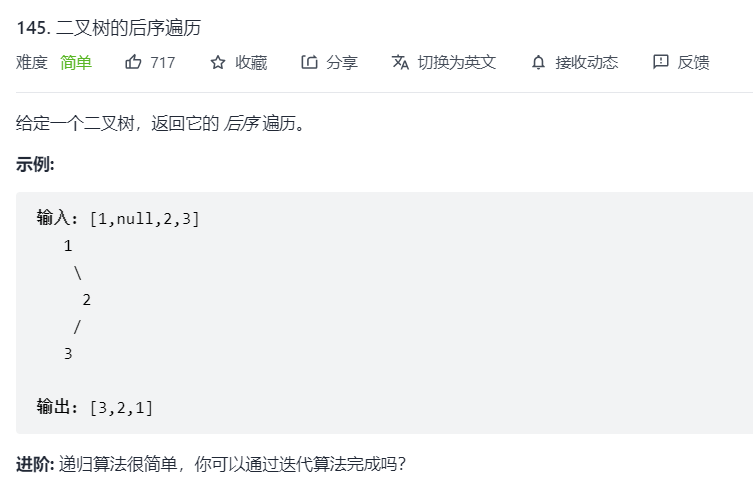
Idea: this question requires that the traversed nodes be put into a List and returned
- Post order traversal order: left child node - > right child node - > root node
- First judge the current root node. If the root node is empty, directly return to list
- Access left child node
- Access the right child node
- Finally, the currently accessed root node value is stored in the sequence table
Implementation code:
class Solution {
List<Integer> list = new ArrayList<>();
public List<Integer> postorderTraversal(TreeNode root) {
if(root==null){//Judge whether the root node is empty
return list;
}
postorderTraversal(root.left);//Access left child node
postorderTraversal(root.right);//Access the right child node
list.add(root.val);//Store the value of the currently accessed root node in the sequence table
return list;
}
}
Judge whether the two trees are the same
Title:
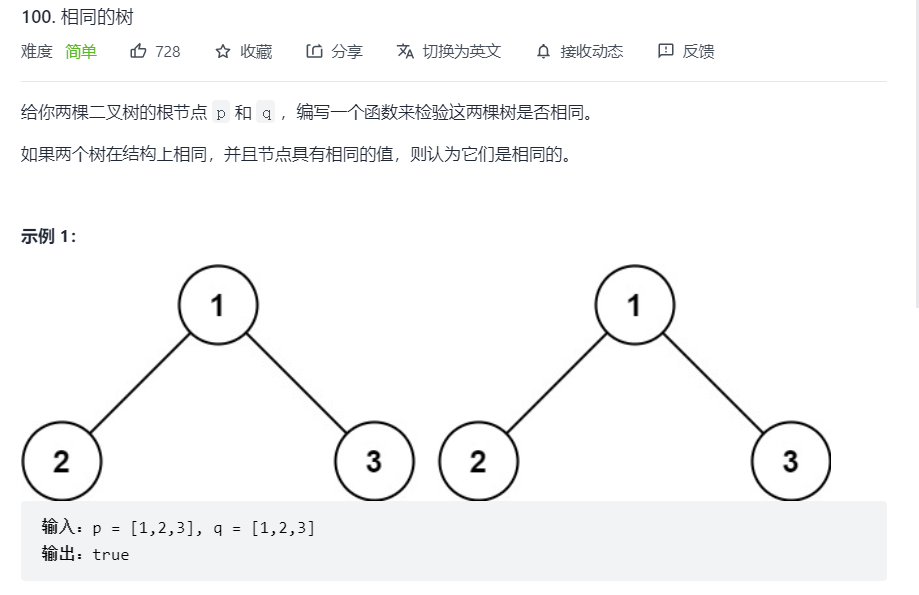
Idea:
- First, make sure that the two trees are the same, which means that the left subtree and the right subtree are the same, and the values are the same
- First, judge whether the root nodes of the two trees are empty. If the root nodes of the two trees are empty, the two trees are the same and return true directly;
- If only the root node of one tree is empty and the root node of the other tree is not empty, the two trees must be different and return false directly
- If the root nodes of the two trees are not empty, compare their values. If the values are different, the two trees are different and return false
- When the above conditions do not return false, that is, the root nodes of the two trees are the same, then use recursion to judge whether their left and right child nodes are the same, and carry out dolly
Implementation code:
class Solution {
public boolean isSameTree(TreeNode p, TreeNode q) {
//Both are empty
if(p == null && q == null) {
return true;
}
//Only one is not empty
if(p == null || q == null) {
return false;
}
//None is empty
if(p.val != q.val) {
return false;
}
//If p and q are not empty and the corresponding values are the same, judge the left and right trees of the two trees
return isSameTree(p.left,q.left) && isSameTree(p.right,q.right);
}
}
Is the other tree a subtree of the current tree
Title:
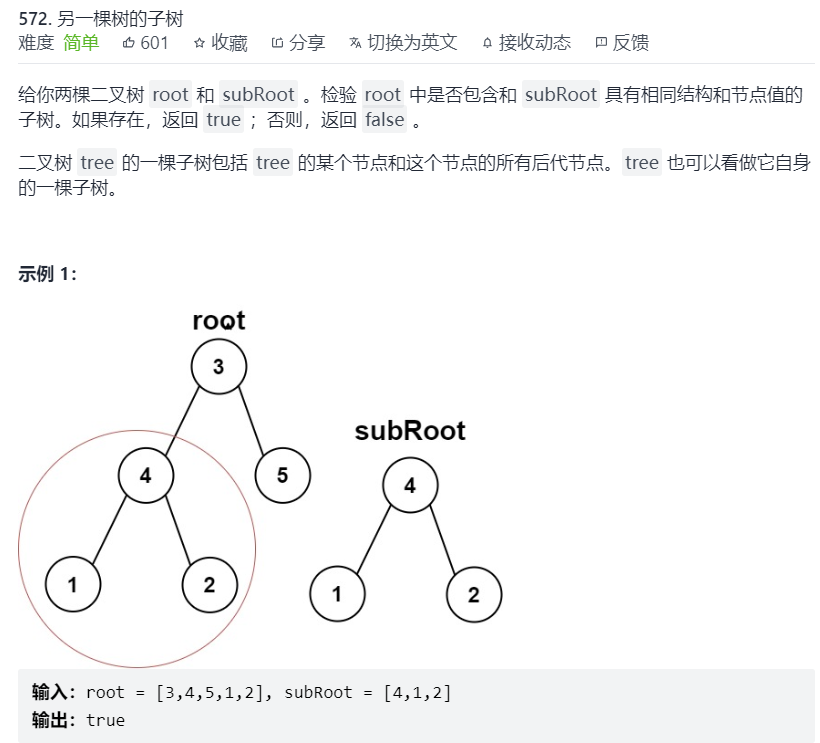
Idea:
- This problem requires as like as two peas of the same tree, which is the same as the last one.
- If the root node of the current tree is empty, the other tree must not be its subtree
- If the root node of another tree is empty, it must be a subtree of the current tree
- Every time a node recurses down, it is necessary to judge whether the tree represented by the current root node is the same as another tree

Implementation code:
class Solution {
public boolean isSubtree(TreeNode root, TreeNode subRoot) {
if (subRoot == null) return true; //If the root node of another tree is empty, it must be a subtree of the current tree
if (root == null) return false; //If the root node of the current tree is empty, the other tree must not be its subtree
return isSubtree(root.left,subRoot)||isSubtree(root.right,subRoot)||isSameTree(root,subRoot);//Before going down a node, it is necessary to judge whether the tree represented by the current root node is the same as another tree
}
public boolean isSameTree(TreeNode s, TreeNode t) {
if (s == null && t == null) return true;//All empty
if (s == null || t == null) return false;//One is not empty
if(s.val!=t.val) return false;//If the values are different, false is returned
//If the values are the same, continue to judge the next node
return isSameTree(s.left, t.left) && isSameTree(s.right, t.right);
}
}
Find the maximum depth of binary tree
Title:
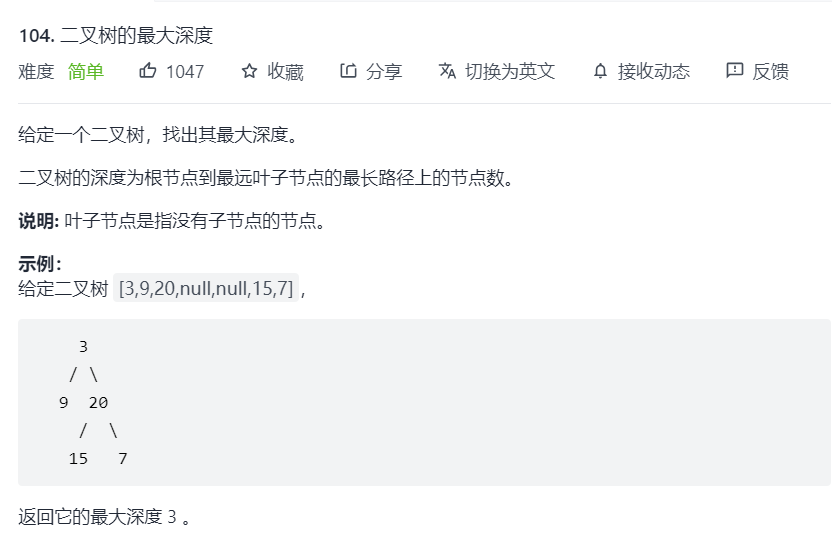
Idea:
- First understand a problem, that is, the depth of the binary tree = the depth of the left subtree and the depth of the right subtree, whichever is greater
- So there is a formula, maximum depth = left subtree depth > right subtree depth? Left subtree depth: right subtree depth
- Using the formula, recursion can be carried out
- First judge whether the current root node is empty. If it is empty, it returns 0 (i.e. the depth is 0)
- Then judge the depth of the left subtree and the right subtree in turn
- Note: when returning, it should be + 1, because the root node is also a layer

Implementation code:
class Solution {
public int maxDepth(TreeNode root) {
if(root==null){//If the root node is empty, 0 is returned
return 0;
}
int a=maxDepth(root.left);//Find the height of the left subtree
int b=maxDepth(root.right);//Find the height of the right subtree
return (a > b ? a : b )+ 1;//Recursive formula
}
}
Judge whether the binary tree is a balanced binary tree
Title:
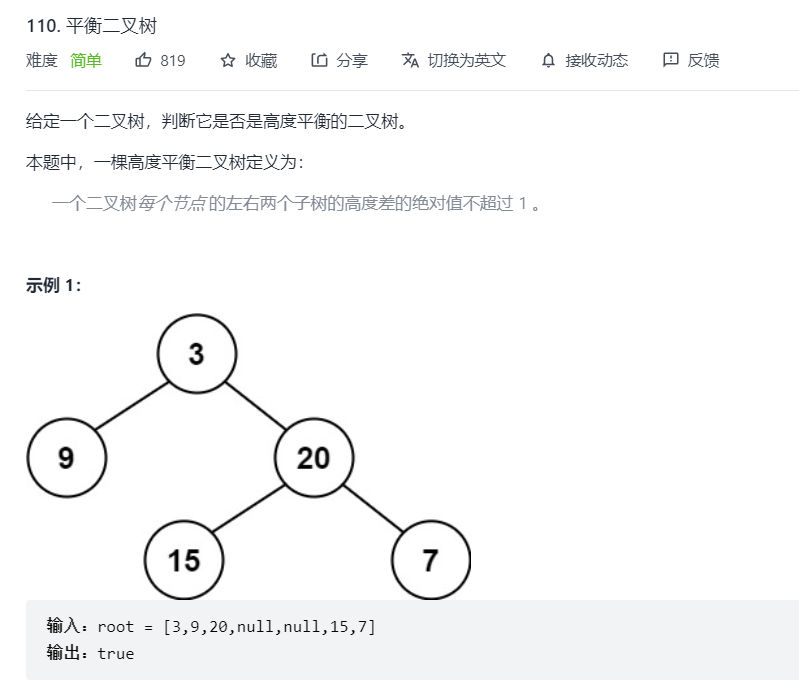
Idea:
- In this question, a highly balanced binary tree is defined as:
The absolute value of the height difference between the left and right subtrees of each node of a binary tree does not exceed 1. - Take the idea of looking from bottom to top and write an additional method to judge the height of the tree
- Judge whether the absolute value of the difference between the left subtree height and the right subtree height of the current root node does not exceed 1
- If the balance condition is met, the subtree height is returned; otherwise, the subtree height is returned
Implementation code:
class Solution {
public boolean isBalanced(TreeNode root) {
if(height(root)>=0)
return true;
else
return false;
}
//Look from bottom to top
public int height(TreeNode root) {
if (root == null) //The root node is empty and returns 0
return 0;
int left = height(root.left);//Get left node height
if(left == -1)
return -1;
int right = height(root.right);//Get right node height
if(right == -1)
return -1;
return Math.abs(left - right) <=2 ? Math.max(left, right) + 1 : -1;
//If the absolute value of the height difference between the left subtree and the right subtree is not greater than 1, the height of the subtree is returned; otherwise, - 1 is returned
}
}
Judge mirror binary tree
Title:

Idea:
- In fact, this problem is to judge whether the left and right subtrees are the same, but a little change needs to be made
- To judge whether it is a mirror image, the change is that the left child value of the left subtree should be equal to the right child value of the right subtree, and the right child value of the left subtree should be equal to the left child value of the right subtree
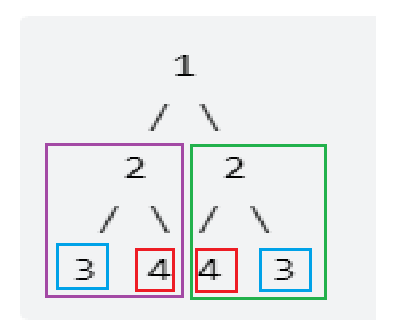
Implementation code:
class Solution {
public boolean isSymmetric(TreeNode root) {
if(root==null){
return false;
}
return isSame(root.left,root.right);//If the left and right subtrees meet the mirror condition, they are mirror binary trees
}
public boolean isSame(TreeNode a,TreeNode b){
if(a == null && b ==null)
return true;
if(a == null || b ==null)
return false;
if(a.val != b.val)
return false;
//The key is the last line of code
//The left child value of the left subtree should be equal to the right child value of the right subtree
//The right child value of the left subtree should be equal to the left child value of the right subtree
return isSame(a.left,b.right)&&isSame(a.right,b.left);
}
}
🌙🌙🌙🌙🌙🌙🌙🌙🌙🌙🌙🌙🌙🌙🌙🌙🌙🌙🌙🌙🌙🌙🌙🌙🌙
❤ Originality is not easy. If there is any error, please leave a message in the comment area. Thank you very much ❤
❤ If you think the content is good, it's not too much to give a three company~ ❤
❤ I'll pay a return visit when I see it~ ❤
🌙🌙🌙🌙🌙🌙🌙🌙🌙🌙🌙🌙🌙🌙🌙🌙🌙🌙🌙🌙🌙🌙